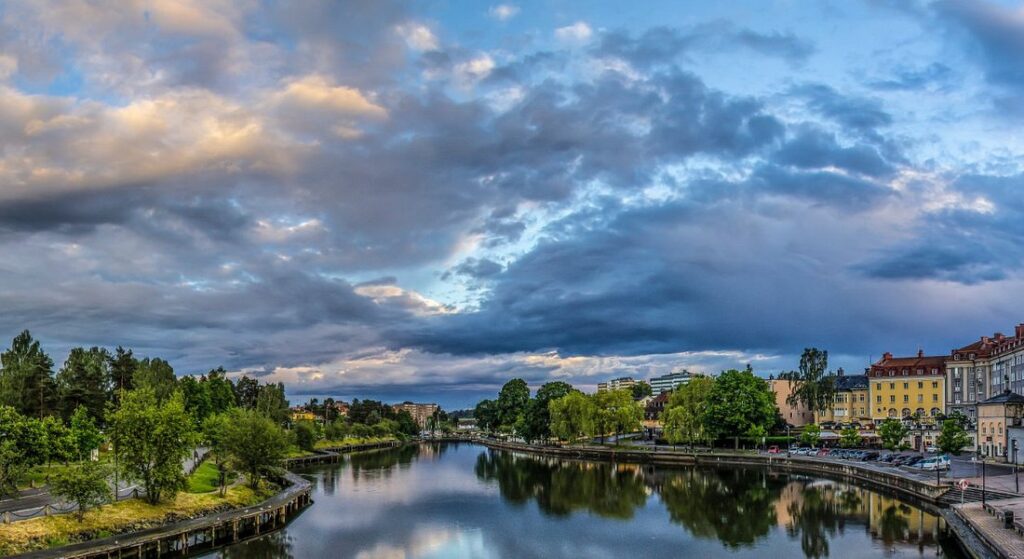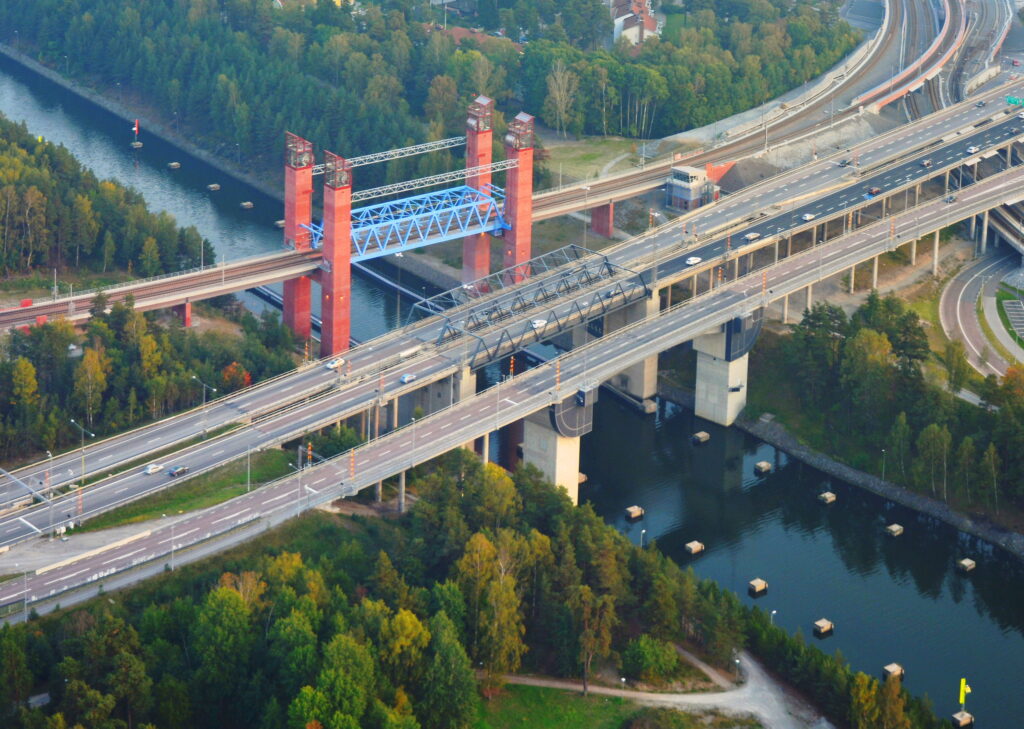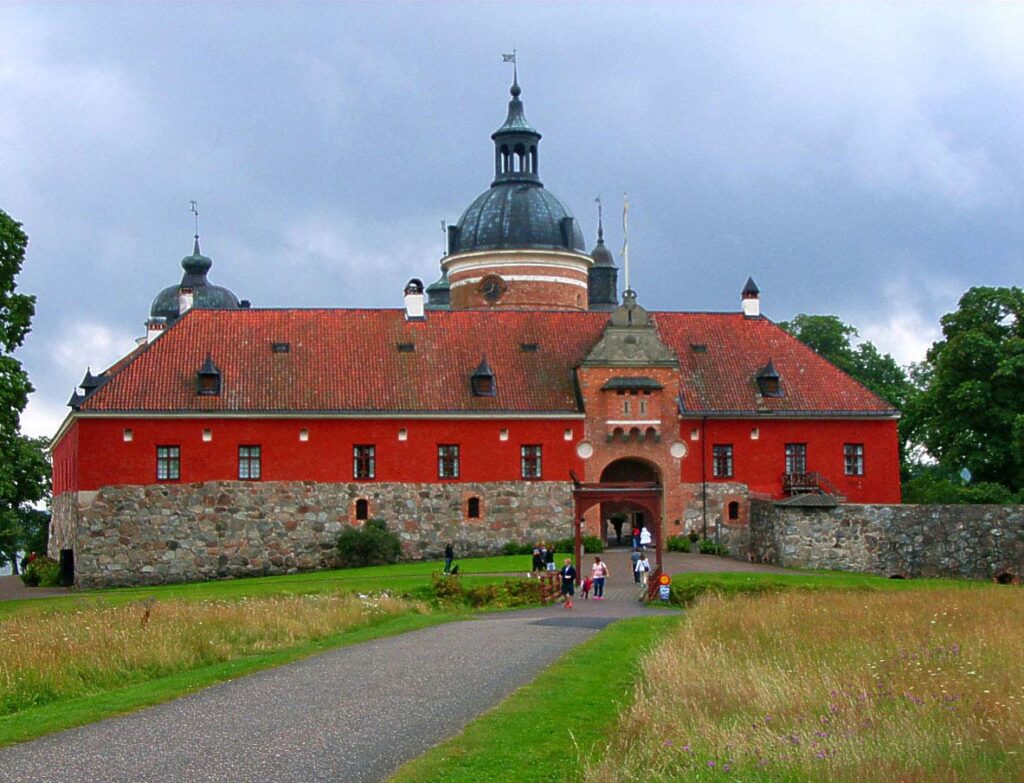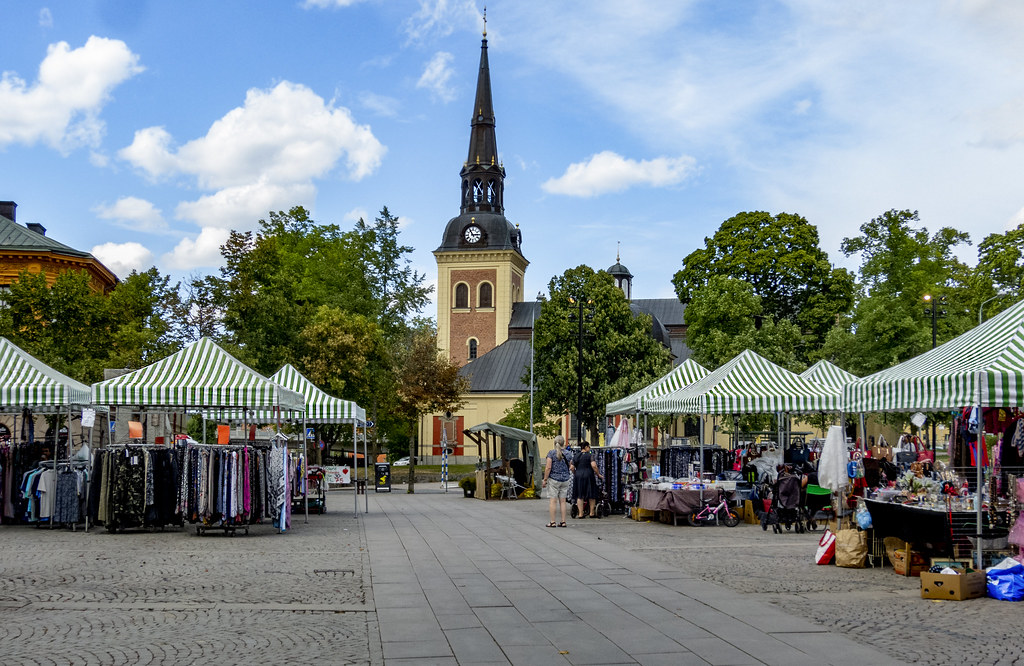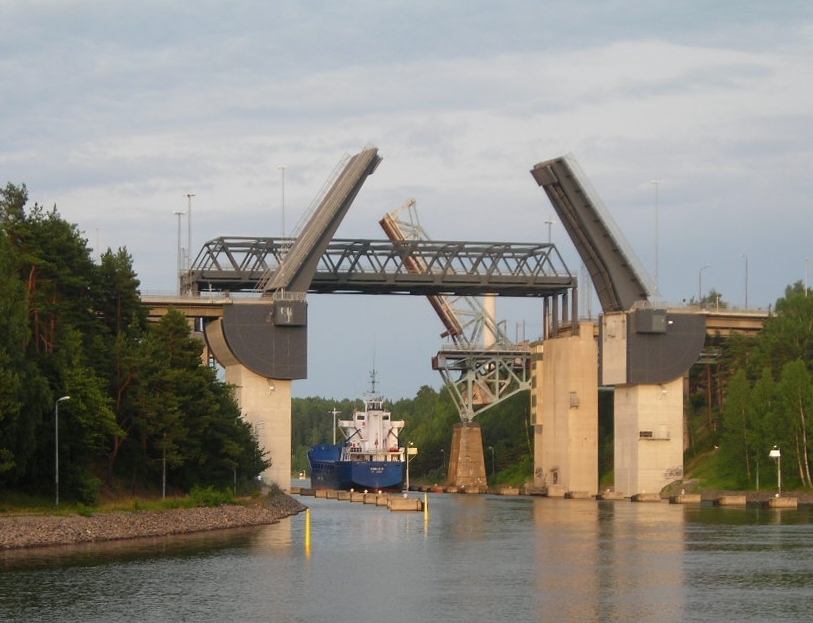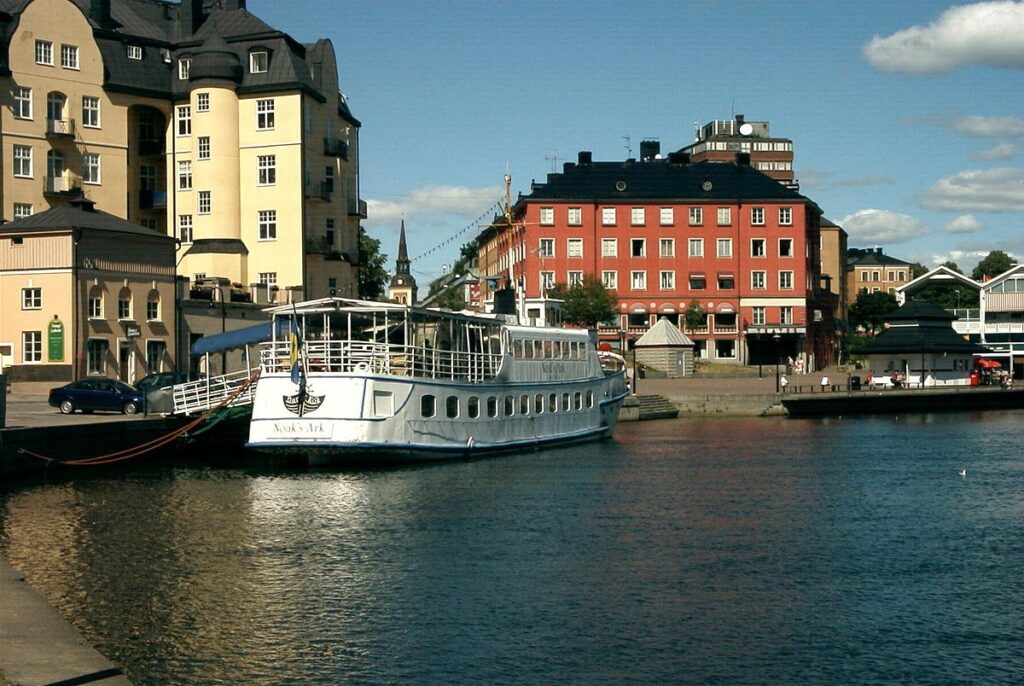Södertälje is a city in Södermanland and Stockholm County, Sweden and seat of Södertälje municipality. As of 2017, it has 72 704 inhabitants. Södertälje is located at Mälarens confluence in to the Baltic Sea through the lock in the Södertälje Canal.
Economy
Södertälje is particularly known for its two large companies Astra Zeneca and Scania. Measured in sheer number of companies, the retail, wholesale and restaurant sectors dominate, with about 1,000 companies. The building and construction industry has about 600 companies in the Södertälje, and some 450 companies in the consultancy sector. In total, there are over 4,000 businesses in the city. Södertälje has a high number of small businesses with five or fewer employees.
Large corporations
Aktiebolaget Astra, Apotekarnes Kemiska Fabriker was founded in 1913 by pharmacist Adolf Rising. Initially, the company had only ten employees, but already developed strongly during the first years. The company started with only five employees, but grew exponentially in its first years of trading. One of the reasons was an increased need for medication due to the first world war. The company merged with its British competitor Zeneca in 1999, and formed the pharmaceutical group Astra Zeneca. The company’s pill factory in Gärtuna in south-eastern Södertälje is the largest of its kind in the world, employing over 3,200 people.
In 1891, Vagnfabriks-Aktiebolaget i Södertelge (abbreviated VABIS) started as manufacturier of railway cars, petrol engines, automobiles, trucks, motor-powered draisines, motorboats and marine engines. In 1911 they merged with Maskinfabriks-aktiebolaget Scania and formed Scania-Vabis. The company only uses the name Scania AB today. The head office remains in its original location, by Saltskogsfjärden south of the city centre of Södertälje. Together with its subsidiaries, Scania currently employs over 9,000 people in Södertälje, making the Group the largest employer.
Retail trade
Most retail shopping is available in the city centre; predominantly on Storgatan and Järnagatan streets, but also adjacent areas. The Kringlan department store was one of the first modern department stores when it opened in 1965. The name Kringlan (English: The Pretzel) is a reference to the long lasting local tradition of selling pretzels in Södertälje. Other department stores include Luna and Telgehuset. Retail shopping outside the city centre is mainly located in Moraberg on the eastern side of the canal, as well as Vasa Handelsplats in the western part. Larger stores are also located around Hansaplan in the Södra area.
Education
KTH Royal Institute of Technology has a campus in Södertälje, where they conduct university education within Mechanical engineering, Logistics and other subjects all the way up to Master’s level including Master of Science in Engineering. Education is given in cooperation with the city’s two large corporations Scania AB and AstraZeneca. In 2018, KTH moved in to a newly built campus in Södertälje Science Park drawn by the architect firm White. The Royal Institute of Technology has 1 200 students and hired researchers in Södertälje.
Several universities conduct higher education at the learning centre Campus Telge. When it started it was located in Mariekälla, but moved to new premises that previously housed the headquarters of Astra AB in 2015. Both individual courses and whole university programmes are offered within a variety of subjects, meaning students can study at the campus all the way until graduation. Education within Yrkeshögskolan (English: Higher Vocational Education) is also held.
Hagabergs folkhögskola started as a Bible Institute in 1910, and became a folk high school in 1957. It is run by the Swedish Evangelical Mission. Around 250 students study at the academy, of which 20 reside at the boarding school. The curriculum mostly centres on studies of Christian theology. The general introductory course for students pursuing a career within the Church of Sweden, as well as “Allmän kurs” which is mostly non-religious and supplements normal secondary school education.
In 2017, Södertälje had 13 secondary schools, 5 of which were municipal and 8 operated as charter schools.
Culture
Södertälje’s primary theatre is Oktoberteatern at Marenplan, which has a number of new productions each year. The venue opened in 1928. It originally contained a cinema called Castor, but was turned in to a theatre after a renovation in 1984. Södertälje is also home to Sweden’s only professional Finnish-language theatre group; Teatteri Kipinä.
One of the most popular cultural centre around the city is Kulturhuset i Ytterjärna (English: The Cultural Centre in Ytterjärna). The complex houses a theatre, café, conference rooms and offices. It opened in 1992, and won second prize for Sweden’s most popular modern building in 2001. During construction, special attention was paid to the acoustics of the premises, which has resulted in many concerts being held here. The concert hall has about 500 seats, and together with other anthroposophical activities receives about 30,000 visitors annually. Other cultural activities include exhibitions on architecture and garden art.
The stages Estrad and Trombon at the City Hall often show theatre as well as concerts and film. The association Molto has organised concerts and creative activities for youth since 2008. A recurring tradition in Södertälje is the local revue Täljerevyn, which makes humorous cabarets about the city, local traits and politics every year.
Museums
Torekällbergets museum (colloquially referred to as just Torekällberget or simply Berget ) with the city museum Södertälje Stadsmuseum, is one of the most popular sights to visit in the city. The museum first opened in 1929 when the landmark windmill and a few other buildings were moved to the site. In connection with the redevelopment of the city centre in 1961, many old buildings were moved to Torekällberget. The museum is divided into the environments “Staden” (English: the City) and “Landet” (English: the Countryside). The urban environment is built around the main square Tenngjutartorget, where markets often are held. The square is surrounded by buildings from the 1700-1800s. Several species of domestic animals are kept at the museum. The environment conveys a picture of life in rural farms around Södertälje in the 1800s and earlier. There is also a stage where ballroom dancing and performances are often arranged during the summer months.
The vehicle museum Marcus Wallenberg-hallen (English: The Marcus Wallenberg Hall) is situated by Saltskogsfjärden, next to the headquarters of Scania AB. The museum is named after the industrialist Marcus Wallenberg Jr.. The collections include a number of older vehicles and environments; like the first mass produced car in Sweden from 1903. It also features railway cars that were owned by the Swedish State Railways, used between the late 1800s until the early 1900s. Exhibited objects have been restored to their original condition. A little less than half of the museum consists of newer vehicles manufactured during the 2000s.
Södertälje is home to a large science museum based on the book La Science Amusante by French writer Arthur Good. The museum is called Tom Tits Experiment after the author’s pen name Tom Tit. It started as a temporary exhibition at Södertälje Hall of Arts (Swedish: Södertälje Konsthall), but became so popular that it was turned in to a permanent museum. The museum is located in an old industrial building at Storgatan street. Today, it is the largest Science centre in Sweden. It occupies four floors, and has a park that is open during the summer season. The exhibitions contain more than 400 science experiments. Tom Tits Experiment received around 190 000 visitors 2018.
Biologiska Museeet (English: The Museum of Biology) was donated to the city by patron Carl Fredrik Liljevalch. The building is in Art Nouveau style, and located on Erik Dahlbergs road. It opened to the public in 1913, thus making it the oldest museum in the city. The exhibitions were created by Gustaf Kolthoff and his son Kjell Kolthoff, and show animals and birds from the province of Sörmland (where Södertälje is located) in their natural environments. In total, there are over 100 different species on display. Kjell Kolthoff painted the large dioramas that have remained to this day. The museum was completely renovated and reopened in 1983.
The world’s oldest propeller-driven steamship which still has its original engine is S/S Ejdern. It was originally built by Götaverken in Gothenburg in 1880. During its first years, Ejdern operated in the Gothenburg archipelago, Lake Roxen, and several ports in central Sweden. Since 1906, it has had its home port in Södertälje. The first route from the port in Södertälje was to Mörkö , and cargo hauls in eastern Lake Mälaren . Between 1914 and 1957, the boat had one single owner; Rickard Fredmark. He sold the boat to the City of Södertälje. At that time, the ship was unprofitable and in very poor condition. The city subsequently decided that the boat was to be scrapped. In 1964 the boat was donated to an association for the preservation of old boats. Enthusiasts of this particular vessel broke out and formed Museiföreningen Ångfartyget Ejdern (English: The Museum Association S/S Ejdern), who still own the boat today. Since 1976 they operate museum routs around Södertälje. From 1984, the boat is once again coal powered. S/S Ejdern has a capacity of 90 people, and often operates the route to Adelsö and Viking city Birka.
Wendela Hebbes hus (English: Wendela Hebbe’s house) is a museum of Wendela Hebbe, who was the first female professional journalist in Sweden. She became employed at the newspaper Aftonbladet in 1841, where she wrote about theatre and music, and translated books. Besides being a journalist, she also wrote fairy tales. The building is a yellow wooden house, with two floors. It first stood at Snäckviken, close to the headquarters of Astra AB. The property was purchased by Lars Johan Hierta in 1863 to serve as a summer house for Wendela, her daughter Signe and the jointly unrecognised son Edvard Faustman. After being acquired by Södertälje Municipality it was moved to its present location between the canal and Marenplan in the city centre, and underwent extensive renovations. The venue houses a restaurant and a museum section with furniture and paintings from the Hebbe and Faustman families. It also acts as a cultural centre, hosting theatres and exhibitions.
Södertälje Konsthall (English: Södertälje Museum of Arts) showcases various exhibitions of paintings, sculptures and other artistic installations. The museum opened in 1968, and relocated to its current premises in Luna in 1978. In 2015, Grafikens Hus (English: House of Graphics) decided to relocate to the city from nearby Mariefred, meaning there would be two art museums in Södertälje.
Libraries
Södertälje’s city library was originally run by an independent association, but was taken over by the City council in 1945. It moved to its present location in 1978. Lectures, courses and theatre are also held at the premises. The library has branches in Hölö, Järna, Enhörna, Hovsjö and Mölnbo. The libraries in Enhörna, Hölö and Mölnbo are combined school and public libraries.
Since year 2000, it is the largest city located entirely within the province of Södermanland.

